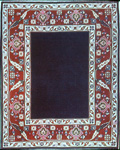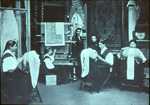 |
|
|
||||||||||||||||
|
A
Moscow Kilim of 1891 The carpet half (Rosalind Benedict, Anita De Carlo, Richard Wright) of the textiles and carpets vetting committee at the fall, 2004, International Art and Antiques Show in New York found another interesting carpet, in this case, a pileless rug (Figure 1) offered by Moheban and Co. as Bessarabian -- which it definitely wasn’t -- but not a bad try for a label.
Inscriptions, however, make the place of origin immediately evident, an orphanage in Moscow. It is the case that deciphering Russian abbreviations can only be done by an experienced person. Wendy Salmond, Co-chair, Department of Art, Chapman University had no trouble at all recognizing that the letters in the printed Cyrillic (Figure 2) identified the orphanage’s patron, Grand Duchess Ksenia Aleksandrovna. Professor Salmond has broadened her interests considerably over the years, but continues as the authority on European Russia’s kustar’ program. (Arts and Crafts in Late Imperial Russia: Reviving the Kustar Art Industries, 1870 – 1917, Cambridge University Press, 1996)
The other writing, that in cursive Roman, (Figure 3) presents difficulties. “Moscow” is in French and clear enough, but what appears to be an individual’s name (possibly but not verifiably Finnish) is only partially legible. At the time French was the language of the Russian upper crust; thus either a local resident or someone overseas is a possible referent.
This individual’s relationship to the rug is a matter of guesswork, but sponsor may be a reasonable notion, possibly for an exhibition with subsequent donation to some organization, or for retention by the orphanage. (It is not likely that a rug with writing on it would have been made for ordinary trade purposes.) In brief, the Grand Duchess was patron of the orphanage; some individual was patron of the rug. Carpets and textiles with western Asia patterns and motifs (Figure 4) occasionally were made in Moscow as training exercises for instructors (Figure 5) going to the provinces to work with kustar’ support organizations, carpet-making being a significant home craft activity in several parts of the empire. Russian awareness if such designs stemmed at least from the 1872 publication by V. V. Stasov if what he termed “Russian peoples ornamentation.” .
As for the New York kilim (12’ 6” x 11’ with relatively fine yarns) it is probably best viewed as a pastiche of a center medallion Persian rug. Although both main border (Figure 6) and angular field drawing (Figure 7) resemble a standard Heriz, each is only generally allusive. Guard borders and individual motifs also show western Asia affinities but are not quite the real thing.
The best bet is that the carpet was made at the orphanage but not
necessarily for it. Child labor was not shunned and, indeed, tended
to be viewed as uplifting in the case of orphans. At bottom, however,
why the rug was made can only be speculated about. One thing is
certain: years later it provided an interesting day in New York.
|





